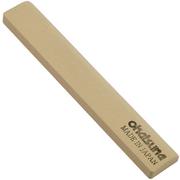Sharpening hedge shears
Why is it important to keep your hedge shears sharp? Sharp hedge shears make trimming your hedge faster, tighter and a lot less frustrating. Whether you use a manual or electric hedge trimmer, proper maintenance and sharpening extends the service life of the tool and ensures that you neatly cut through branches instead of bruising them. In this article, we explain how to sharpen hedge shears, which tools to use and how to properly maintain your hedge shears.
How do you sharpen hedge shears?
Sharpening always starts with good preparation. Clean the knives first, how to do this is explained later in this article. Check the blade for any damage. Depending on the state of the blade, decide whether you will sharpen by hand, or whether an electric sharpener is needed for heavier work.
What types of hedge shears exist?
There are different types of hedge shears, and that also determines how best to sharpen them:
- Sharpening regular hedge shears: The easiest way to do this is as above, using a sharpening stone or file.
- Electric hedge shears: These often have a lot of small serrations, or teeth. Sharpen the teeth, one by one with a file or flat small sharpening stone.
Want to learn more about sharpening different types of garden tools? Check out our tips on sharpening garden tools.
Which sharpening tools are recommended for hedge shears?
For most hedge shears, a sharpening stone with a medium/coarse grit size will be sufficient. Preferably choose a compact sharpening stone that fits well in your hand, so you can move along the edge in a controlled way. A good example is the Skerper Pocket Stone.
Please note: hedge shears don't need the same level of sharpness as kitchen knives. A course to medium grit size (for example, 200 to 600 grit) will usually be sufficient. This will remove burrs and damage fairly quickly.
Step-by-step: Sharpening hedge shears
Start by sharpening the cutting edge. Place the whetstone at the right angle against the blade (usually around 30 degrees) and move in long, even strokes along the edge. Repeat until you feel that the edge feels sharp again and you visually see an even, shiny edge.
Then turn the hedge shears over and feel on the other side whether a burr has appeared. This is a small, raised edge of metal that you simply remove by a few light strokes with the sharpening stone on the other side. Don't actually sharpen the back of the blade though, just 'break’ the burr.
Repeat this process with the other blade. How long you need to sharpen depends very much on how dull the edge is, but usually 5 to 20 strokes per side will be enough. You are done when the edge feels smooth and sharp again, without damage or burrs.
Hedge shears maintenance
Sharp hedge shears are great, but without proper maintenance this tool won't stay in that condition for long. Regular cleaning, lubrication and resharpening makes your work more pleasant, prevents rust, extends the service life and reduces the need for major sharpening.
When will this be necessary?
We recommend doing a quick check after every time you use your shears. Remove dirt and sap with a cloth or brush. More thorough maintenance is recommended after each intensive pruning, when you notice that cutting becomes more difficult or at the beginning and end of the season.
Cleaning hedge shears
- 1: Remove dirt: Use a cloth or brush to remove soil or leaves.
- 2: Clean: Is there any resin or tree sap on the blades? Remove it using alcohol or resin remover.
- 3: Protect from rust: After cleaning, apply a coat of oil to the blades.
- 4: Check the screws: Ensure all parts are fixed to the construction like they should.

























?%24center=center&%24poi=poi&%24product-image%24=&fmt=auto&h=500&poi=%7B%24this.metadata.pointOfInterest.x%7D%2C%7B%24this.metadata.pointOfInterest.y%7D%2C%7B%24this.metadata.pointOfInterest.w%7D%2C%7B%24this.metadata.pointOfInterest.h%7D&scaleFit=%7B%28%24this.metadata.pointOfInterest%29%3F%24poi%3A%24center%7D&sm=c&w=1208)